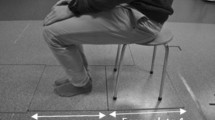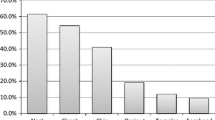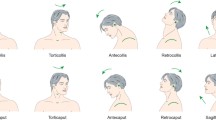Abstract
Background
Patients with idiopathic cervical dystonia (CD) experience involuntary neck muscle contractions, abnormal head position and pain accompanied by dysfunctions in somatosensory processes such as postural control, cervical sensorimotor and perception of visual verticality. First-line treatment is injection with botulinum toxin (BoNT). It remains unclear whether this affects sensorimotor processes.
Aim
To investigate the effect of first-line care on deficiencies in somatosensory processes.
Methods
In this observational study, 24 adult patients with idiopathic CD were assessed three times over a treatment period of 12 weeks following a single treatment with BoNT. Disease severity was assessed by a disease-specific questionnaire, rating scale and the visual analogue scale. Seated postural control was assessed with posturography, cervical sensorimotor control was assessed by the joint repositioning error with an eight-camera infrared motion analysis system during a head repositioning accuracy test and perception of visual verticality was assessed with the subjective visual vertical test.
Results
Disease symptoms significantly improved following BoNT injections and deteriorated again at 12 weeks. This improvement was not accompanied by improved postural control, cervical sensorimotor control and perception of visual verticality. A trend toward improvement was seen; however, it did not reach the level of the control population.
Conclusion
The peripheral and central treatment effects of BoNT have little to no effect on postural and cervical sensorimotor control in CD. Further research may explore whether sensory training or specialized exercise therapy improves somatosensory integration and everyday functioning in patients with CD.



Similar content being viewed by others
References
Jinnah HA, Albanese A (2014) The new classification system for the dystonias: why was it needed and how was it developed? Mov Disord Clin Pract 1:280–284. https://doi.org/10.1002/mdc3.12100
Neychev VK, Gross RE, Lehéricy S et al (2011) The functional neuroanatomy of dystonia. Neurobiol Dis 42:185–201. https://doi.org/10.1016/j.nbd.2011.01.026
Opavský R, Hluštík P, Otruba P, Kaňovský P (2011) Sensorimotor network in cervical dystonia and the effect of botulinum toxin treatment: a functional MRI study. J Neurol Sci 306:71–75. https://doi.org/10.1016/j.jns.2011.03.040
Tinazzi M, Rosso T, Fiaschi A (2003) Role of the somatosensory system in primary dystonia. Mov Disord 18:605–622. https://doi.org/10.1002/mds.10398
Tinazzi M, Fiorio M, Fiaschi A et al (2009) Sensory functions in dystonia: insights from behavioral studies. Mov Disord 24:1427–1436. https://doi.org/10.1002/mds.22490
Konczak J, Abbruzzese G (2013) Focal dystonia in musicians: linking motor symptoms to somatosensory dysfunction. Front Hum Neurosci 7:297. https://doi.org/10.3389/fnhum.2013.00297
Patel N, Jankovic J, Hallett M (2014) Sensory aspects of movement disorders. Lancet Neurol 13:583–592. https://doi.org/10.1016/S1474-4422(13)70213-8
Bove M, Brichetto G, Abbruzzese G et al (2007) Postural responses to continuous unilateral neck muscle vibration in standing patients with cervical dystonia. Mov Disord 22:498–503. https://doi.org/10.1002/mds.21357
De Pauw J, Mercelis R, Hallemans A et al (2017) Cervical sensorimotor control in idiopathic cervical dystonia: a cross-sectional study. Brain Behav. https://doi.org/10.1002/brb3.735
de Pauw J, Mercelis R, Hallemans A et al (2018) Postural control and the relation with cervical sensorimotor control in patients with idiopathic adult-onset cervical dystonia. Exp Brain Res. https://doi.org/10.1007/s00221-018-5174-x
Albanese A, Asmus F, Bhatia KP et al (2011) EFNS guidelines on diagnosis and treatment of primary dystonias. Eur J Neurol 18:5–18. https://doi.org/10.1111/j.1468-1331.2010.03042.x
De Pauw J, Van der Velden K, Meirte J et al (2014) The effectiveness of physiotherapy for cervical dystonia: a systematic literature review. J Neurol 1857–1865. https://doi.org/10.1007/s00415-013-7220-8
Prudente CN, Zetterberg L, Bring A et al (2018) Systematic review of rehabilitation in focal dystonias: classification and recommendations. Mov Disord Clin Pract 0:1–9. https://doi.org/10.1002/mdc3.12574
Jankovic J (2017) Botulinum toxin: state of the art. Mov Disord 32:1131–1138. https://doi.org/10.1002/mds.27072
Rosales RL, Dressler D (2010) On muscle spindles, dystonia and botulinum toxin. Eur J Neurol 17(Suppl 1):71–80. https://doi.org/10.1111/j.1468-1331.2010.03056.x
Trompetto C, Currà A, Buccolieri A et al (2006) Botulinum toxin changes intrafusal feedback in dystonia: a study with the tonic vibration reflex. Mov Disord 21:777–782. https://doi.org/10.1002/mds.20801
Kristjansson E, Treleaven J (2009) Sensorimotor function and dizziness in neck pain: implications for assessment and management. J Orthop Sports Phys Ther 39:364–377. https://doi.org/10.2519/jospt.2009.2834
Clemens IAH, De Vrijer M, Selen LPJ et al (2011) Multisensory processing in spatial orientation: an inverse probabilistic approach. J Neurosci 31:5365–5377. https://doi.org/10.1523/JNEUROSCI.6472-10.2011
Albanese A, Bhatia K, Bressman SB et al (2013) Phenomenology and classification of dystonia: a consensus update. Mov Disord 28:863–873. https://doi.org/10.1002/mds.25475
Odergren T, Hjaltason H, Kaakkola S et al (1998) A double blind, randomised, parallel group study to investigate the dose equivalence of Dysport and Botox in the treatment of cervical dystonia. J Neurol Neurosurg Psychiatry 64:6–12. https://doi.org/10.1136/jnnp.64.1.6
Albanese A, Del Sorbo F, Comella C et al (2013) Dystonia rating scales: critique and recommendations. Mov Disord 28:874–883. https://doi.org/10.1002/mds.25579
Hawker GA, Mian S, Kendzerska T, French M (2011) Measures of adult pain: visual analog scale for pain (VAS pain), numeric rating scale for pain (NRS pain), McGill pain questionnaire (MPQ), short-form McGill pain questionnaire (SF-MPQ), chronic pain grade scale (CPGS), short form-36 bodily pain scale (SF). Arthritis Care Res 63:240–252. https://doi.org/10.1002/acr.20543
Kelly AM (2001) The minimum clinically significant difference in visual analogue scale pain score does not differ with severity of pain. Emerg Med J 18:205–207
Gatev P, Thomas S, Kepple T, Hallett M (1999) Feedforward ankle strategy of balance during quiet stance in adults. J Physiol 514:915–928. https://doi.org/10.1111/j.1469-7793.1999.915ad.x
Hill R, Jensen P, Baardsen T et al (2009) Head repositioning accuracy to neutral: a comparative study of error calculation. Man Ther 14:110–114. https://doi.org/10.1016/j.math.2008.02.008
Michiels S, De Hertogh W, Truijen S et al (2013) The assessment of cervical sensory motor control: a systematic review focusing on measuring methods and their clinimetric characteristics. Gait Posture 38:1–7. https://doi.org/10.1016/j.gaitpost.2012.10.007
Sanders K, Vereeck LHA (2012) Reliability of VICON measurements. Antwerp Univ. https://doi.org/10.1017/CBO9781107415324.004
Revel M, Andre-Deshays C, Minguet M (1991) Cervicocephalic kinesthetic sensibility in patients with cervical pain. Arch Phys Med Rehabil 72:288–291
Treleaven J, Jull G, Sterling M (2003) Dizziness and unsteadiness following whiplash injury: characteristic features and relationship with cervical joint position error. J Rehabil Med 35:36–43
Latash ML, Ferreira SS, Wieczorek SA, Duarte M (2003) Movement sway: changes in postural sway during voluntary shifts of the center of pressure. Exp Brain Res 150:314–324. https://doi.org/10.1007/s00221-003-1419-3
Prieto TE, Myklebust JB, Hoffmann RG et al (1996) Measures of postural steadiness: differences between healthy young and elderly adults. IEEE Trans Biomed Eng 43:956–966. https://doi.org/10.1109/10.532130
Duarte M, Freitas SM (2010) Revision of posturography based on force plate for balance evaluation. Rev Bras Fisioter 14:183–192
Carpenter MG, Frank JS, Winter D, Peysar GW (2001) Sampling duration effects on centre of pressure summary measures. Gait Posture 13:35–40
Saeys W, Vereeck L, Bedeer A et al (2010) Suppression of the E-effect during the subjective visual and postural vertical test in healthy subjects. Eur J Appl Physiol 109:297–305. https://doi.org/10.1007/s00421-010-1355-4
Saeys W, Vereeck L, Truijen S et al (2012) Influence of sensory loss on the perception of verticality in stroke patients. Disabil Rehabil 34:1965–1970. https://doi.org/10.3109/09638288.2012.671883
Müller G (1916) Über das Aubertsche phänomen. Z Sinnesphysiol 49:109–246
Zoons E, Dijkgraaf MGW, Dijk JM et al (2012) Botulinum toxin as treatment for focal dystonia: a systematic review of the pharmaco-therapeutic and pharmaco-economic value. J Neurol 259:2519–2526. https://doi.org/10.1007/s00415-012-6510-x
Rosengren SM, Colebatch JG (2010) Vestibular evoked myogenic potentials are intact in cervical dystonia. Mov Disord 25:2845–2853. https://doi.org/10.1002/mds.23422
Malone A, Manto M, Hass C (2014) Dissecting the links between cerebellum and dystonia. Cerebellum 13:666–668. https://doi.org/10.1007/s12311-014-0601-4
Filip P, Lungu OV, Bareš M (2013) Dystonia and the cerebellum: a new field of interest in movement disorders? Clin Neurophysiol 124:1269–1276. https://doi.org/10.1016/j.clinph.2013.01.003
Prudente CN, Hess EJ, Jinnah HA (2014) Dystonia as a network disorder: what is the role of the cerebellum? Neuroscience 260:23–35. https://doi.org/10.1016/j.neuroscience.2013.11.062
Kaňovský P, Rosales RL (2011) Debunking the pathophysiological puzzle of dystonia–with special reference to botulinum toxin therapy. Parkinsonism Relat Disord 17(Suppl 1):S11–S14. https://doi.org/10.1016/j.parkreldis.2011.06.018
Jankovic J (2004) Botulinum toxin in clinical practice. J Neurol Neurosurg Psychiatry 75:951–957. https://doi.org/10.1136/jnnp.2003.034702
Dresel C, Bayer F, Castrop F et al (2011) Botulinum toxin modulates basal ganglia but not deficient somatosensory activation in orofacial dystonia. Mov Disord 26:1496–1502. https://doi.org/10.1002/mds.23497
Gilio F, Curra A, Lorenzano C et al (2000) Effects of botulinum toxin type A on intracortical inhibition in patients with dystonia. Ann Neurol 48:20–26
Kafiovskf P, Streitovb H, Dufek J et al (1998) Change in lateralization of the P22/N30 cortical component of median nerve somatosensory evoked potentials in patients with cervical dystonia after successful treatment with botulinum toxin A. 108–117
Delnooz CCS, Pasman JW, Beckmann CF, van de Warrenburg BPC (2013) Task-free functional MRI in cervical dystonia reveals multi-network changes that partially normalize with botulinum toxin. PLoS One 8:e62877. https://doi.org/10.1371/journal.pone.0062877
Duarte GS, Castelão M, Rodrigues FB et al (2016) Botulinum toxin type A versus botulinum toxin type B for cervical dystonia. Cochrane Database Syst Rev. https://doi.org/10.1002/14651858.CD004314.pub3
Iannetti GD, Mouraux A (2010) From the neuromatrix to the pain matrix (and back). Exp Brain Res 205:1–12. https://doi.org/10.1007/s00221-010-2340-1
Treleaven J (2008) Sensorimotor disturbances in neck disorders affecting postural stability, head and eye movement control. Man Ther 13:2–11. https://doi.org/10.1016/j.math.2007.06.003
Palmgren PJ, Andreasson D, Eriksson M, Hägglund A (2009) Cervicocephalic kinesthetic sensibility and postural balance in patients with nontraumatic chronic neck pain–a pilot study. Chiropr Osteopat 17:6. https://doi.org/10.1186/1746-1340-17-6
Vuillerme N, Pinsault N (2009) Experimental neck muscle pain impairs standing balance in humans. Exp Brain Res 192:723–729. https://doi.org/10.1007/s00221-008-1639-7
Stanton TR, Leake HB, Chalmers KJ et al (2016) Evidence of impaired proprioception in chronic, idiopathic neck pain: systematic review and meta-analysis. Phys Ther 96:876–887. https://doi.org/10.2522/ptj.20150241
Bove M, Fenoggio C, Tacchino a et al (2009) Interaction between vision and neck proprioception in the control of stance. Neuroscience 164:1601–1608. https://doi.org/10.1016/j.neuroscience.2009.09.053
Röijezon U, Clark NC, Treleaven J (2015) Proprioception in musculoskeletal rehabilitation. Part 1: basic science and principles of assessment and clinical interventions. Man Ther 20:368–377. https://doi.org/10.1016/j.math.2015.01.008
Falla D, Farina D (2008) Neuromuscular adaptation in experimental and clinical neck pain. J Electromyogr Kinesiol 18:255–261. https://doi.org/10.1016/j.jelekin.2006.11.001
Kulkarni V, Chandy MJ, Baby KS (2001) Quantitative study of muscle spindles in suboccipital muscles of human foetuses. Neurol India 49:355
Boyd-Clark LC, Briggs C, Galea MP (2002) Muscle spindle distribution, morphology, and density in longus colli and multifidus muscles of the cervical spine. Spine (Phila Pa 1976) 27:694–701. https://doi.org/10.1097/00007632-200204010-00005
Wöber E, Schnider P, Steinhoff N et al (1999) Posturographic findings in patients with idiopathic cervical dystonia before and after local injections with botulinum toxin. Eur Neurol 41:194–200
Peterka RJ, Loughlin PJ (2004) Dynamic regulation of sensorimotor integration in human postural control. J Neurophysiol 91:410–423. https://doi.org/10.1152/jn.00516.2003
Peterka RJ (2002) Sensorimotor integration in human postural control. J Neurophysiol 88:1097–1118. https://doi.org/10.1152/jn.00605.2001
Blood AJ, Tuch DS, Makris N et al (2006) White matter abnormalities in dystonia normalize after botulinum toxin treatment. Neuroreport 17:1251–1255. https://doi.org/10.1097/01.wnr.0000230500.03330.01.White
Jull G, Falla D, Treleaven J et al (2007) Retraining cervical joint position sense: the effect of two exercise regimes. J Orthop Res 404–412. https://doi.org/10.1002/jor
Humphreys BK, Irgens PM (2002) The effect of a rehabilitation exercise program on head repositioning accuracy and reported levels of pain in chronic neck pain subjects. J Whiplash Relat Disord 1:99–112. https://doi.org/10.3109/J180v01n01_09
Jahanshahi M (2000) Factors that ameliorate or aggravate spasmodic torticollis. J Neurol Neurosurg Psychiatry 68:227–229
de Vries J, Ischebeck BK, Voogt LP et al (2015) Joint position sense error in people with neck pain: a systematic review. Man Ther 20:736–744. https://doi.org/10.1016/j.math.2015.04.015
Humphreys BK (2008) Cervical outcome measures: testing for postural stability and balance. J Manipulative Physiol Ther 31:540–546. https://doi.org/10.1016/j.jmpt.2008.08.007
Low DC, Walsh GS, Arkesteijn M (2017) Effectiveness of exercise interventions to improve postural control in older adults: a systematic review and meta-analyses of centre of pressure measurements. Sport Med 47:101–112. https://doi.org/10.1007/s40279-016-0559-0
Defazio G, Jankovic J, Giel JL, Papapetropoulos S (2013) Descriptive epidemiology of cervical dystonia. Tremor Other Hyperkinet Mov (N Y). doi: tre-03-193-4374-2 [pii]
Jost WH, Tatu L (2015) Selection of muscles for botulinum toxin injections in cervical dystonia. Mov Disord Clin Pract 2:224–226. https://doi.org/10.1002/mdc3.12172
Hallett M, Albanese A, Dressler D et al (2013) Evidence-based review and assessment of botulinum neurotoxin for the treatment of movement disorders. Toxicon 67:94–114. https://doi.org/10.1016/j.toxicon.2012.12.004
Simpson DM, Blitzer A, Brashear A et al (2008) Assessment: Botulinum neurotoxin for the treatment of movement disorders (an evidence-based review): report of the Therapeutics and Technology Assessment Subcommittee of the American Academy of Neurology. Neurology 70:1699–1706. https://doi.org/10.1007/s00394-015-0841-1.A
Mordin M, Masaquel C, Abbott C, Copley-Merriman C (2014) Factors affecting the health-related quality of life of patients with cervical dystonia and impact of treatment with abobotulinumtoxinA (Dysport): results from a randomised, double-blind, placebo-controlled study. BMJ Open 4:e005150. https://doi.org/10.1136/bmjopen-2014-005150
Comella CL, Jankovic J, Truong DD et al (2011) Efficacy and safety of incobotulinumtoxinA (NT 201, XEOMIN®, botulinum neurotoxin type A, without accessory proteins) in patients with cervical dystonia. J Neurol Sci 308:103–109. https://doi.org/10.1016/j.jns.2011.05.041
Acknowledgements
This study was performed at and with support from the Multidisciplinary Motor Centre Antwerp (M2OCEAN) that was established by means of a Hercules Grant type 2 for medium-sized research infrastructure from the Flemish Research Council (AUHA/09/006).
Funding
University Antwerp (G815).
Author information
Authors and Affiliations
Corresponding author
Ethics declarations
Conflicts of interest
No conflict of interest is to be reported.
Electronic supplementary material
Below is the link to the electronic supplementary material.
Rights and permissions
About this article
Cite this article
De Pauw, J., Cras, P., Truijen, S. et al. The effect of a single botulinum toxin treatment on somatosensory processing in idiopathic isolated cervical dystonia: an observational study. J Neurol 265, 2672–2683 (2018). https://doi.org/10.1007/s00415-018-9045-y
Received:
Revised:
Accepted:
Published:
Issue Date:
DOI: https://doi.org/10.1007/s00415-018-9045-y




